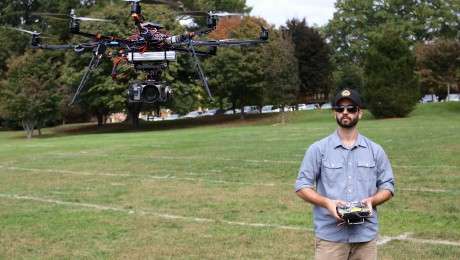Flying robot will provide a unique view of the world's most biodiverse ecosystem

Soaring over a dense canopy of trees, a flying, insect-like robot developed by Wake Forest researchers will give an unprecedented look at Peru's tropical cloud forest, one of the world's most biodiverse ecosystems.
The Peruvian cloud forest grows on the slopes of the Andes Mountains and marks the western border of the Amazon rainforest. This expansive region stretches across a swath of South America approximately the size of the continental United States. Few people truly grasp and appreciate its critically important role – driving the world's climate and weather patterns and annually absorbing 1.5 billion metric tons of C02.
Even scientists know very little about the estimated 390 billion trees that make up this vitally important ecosystem. After all, the remote nature of the Amazon and its almost complete lack of infrastructure make it one of the most difficult places to reach, and therefore, hardest to study places in the world.
A bird's eye view
Max Messinger, a biology graduate student, Marcus Wright, a chemistry lab manager, and Miles Silman, a biology professor and director of the Center for Energy, Environment and Sustainability (CEES), have come up with a novel solution to this problem.
"We were sitting in the lab brainstorming ideas about how to observe things in the canopy of Peru's tropical forest," Messinger said. "You can't see anything useful from the ground so we came up with the idea to use an unmanned aerial vehicle or drone."
Messinger and Wright received funding from CEES and the National Science Foundation to assemble and test two different drones for use in the cloud forest. The first, a copter drone, relies on eight small propeller units and is capable of flying at 15 mph for up to 20 minutes at a time. It can be equipped with either a conventional visible light or thermal imaging camera to gather data on everything from leaf and flower characteristics to temperature readings and animal behavior.
"We will utilize its hover capability to take off from small tree-fall gaps in the rainforest and observe things like monkeys feeding or something like that for an extended period of time," Messinger said.
Their second robot resembles a small airplane. Launched like a javelin, it uses a single electric motor and propeller to fly up to 50 mph for over an hour.
"We can map much more territory with the plane because it can fly three times farther," Messinger said. "The drawback is that it can't carry the fancier sensors we use on the copter."
Messinger said both robots are capable of taking pictures of an object from multiple viewpoints. They then use that data to build three-dimensional models that can be studied in the lab. "It works in a way that is really quite similar to how a human uses their eyes," he said.
Rather than relying on a human operator, the drones fly autonomously, using global positioning data, compass coordinates and onboard stabilization systems.
"We plug all of that info into our mission planning software, which generates the flight plan and sends it to the aircraft," Messinger said. "It is then as simple as launching it, flipping a switch and waiting for it to finish."
Drones collecting data
To date, forest canopy data is hard to come by.
Silman, who has spent his career conducting research in the tropics, said data is currently collected via remote satellite sensing or manually from the ground or a crane.
"While there is satellite data on temperature and thermal distribution in the Amazon going back to the early 1970s, it doesn't provide the resolution necessary to build the detailed models we need," he said. "The only other alternative is to rent out a helicopter, which is far too expensive for any kind of continuous observation."
Messinger said the drones will allow Wake Forest researchers to gather thermal data down to a few centimeters and visible light data down to the sub centimeter level, a big improvement over current satellite capabilities.
"This will allow us for the first time to see how individual canopies are functioning on a landscape level to fix carbon and release oxygen and water," Messinger said. "Once we build a better understanding of why the forest is behaving in a certain way we can start making decisions about how do we conserve this region and ensure that it continues to function."
Provided by Wake Forest University




















